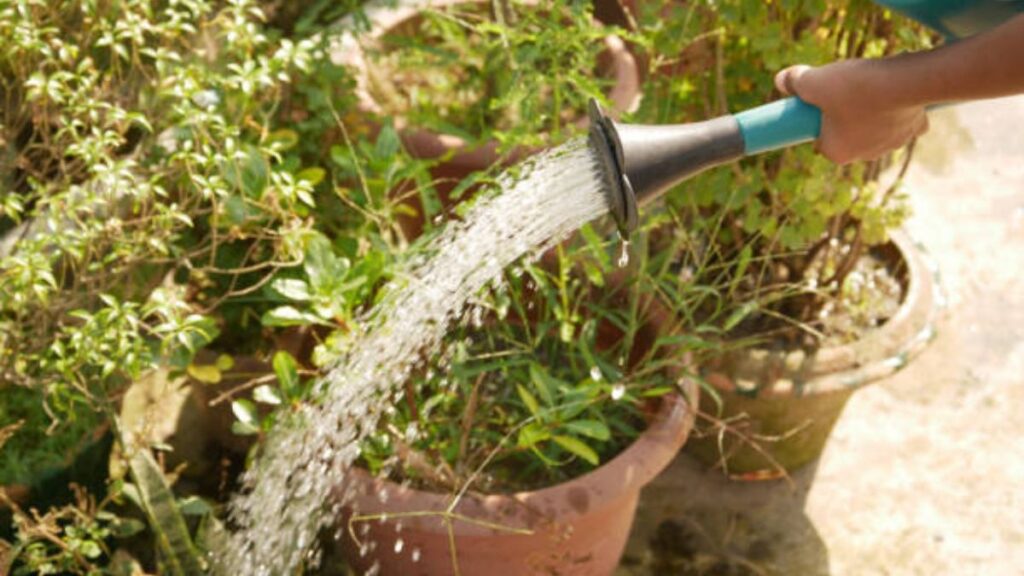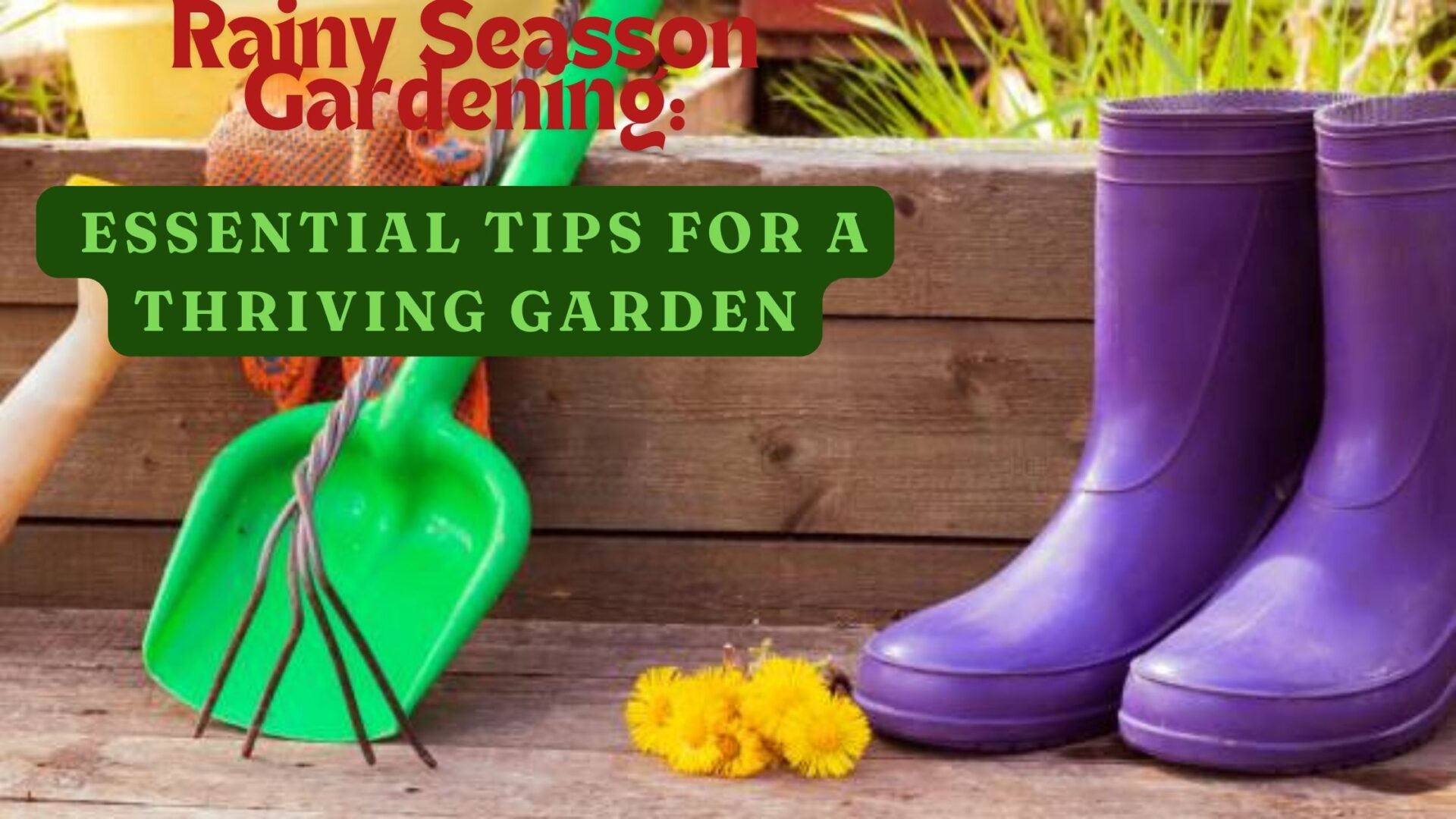Introduction:-
Rainy Season Gardening: Essential Tips for a Thriving Garden

Gardening during the rainy season poses distinct challenges and offers unique opportunities. The plentiful water can foster vibrant growth, yet excessive rainfall can result in issues like waterlogging, plant diseases, and nutrient loss. To ensure your garden flourishes amid rainy days, specific care strategies are essential. This guide presents valuable tips to help your garden thrive, even in the wettest conditions.
Essential Tips for Rainy Seasson Gardening
Rainy Season Gardening Tips:
1. Soil Drainage:
- Improve soil drainage to prevent waterlogging and root rot during heavy rains.
- Amend the soil with organic matter like compost or manure to enhance structure and drainage.
2. Raised Beds:
- Build raised beds to elevate plants above ground level.
- Raised beds improve drainage and reduce the risk of waterlogging, keeping roots healthy and dry.
3. Mulching:
- Apply a thick layer of organic mulch around plants to regulate moisture and temperature.
- Mulch helps reduce runoff, conserve soil moisture, and suppress weeds.
4. Plant Health Monitoring:
- Regularly inspect plants for signs of disease and pests, especially during rainy weather.
- Early detection and treatment can prevent the spread of diseases and minimize garden damage.
5. Pruning and Trimming:
- Trim overgrown plants and remove dead or diseased foliage to promote air circulation.
- Pruning reduces humidity and lowers the risk of fungal infections.
6. Watering Practices:
- Water your garden early in the morning during rainy periods, especially for container plants or sheltered areas.
- Watering in the morning helps prevent fungal diseases.
7. Plant Spacing:
- Ensure proper spacing between plants to avoid overcrowding and promote good air circulation.
- Adequate spacing reduces humidity levels and lowers the risk of fungal infections.
8. Delicate Plants Protection:
- Provide support to tall or fragile plants using stakes or cages to prevent damage from heavy rain and strong winds.
9. Weed Management:
- Regularly remove weeds to prevent competition for nutrients and water, especially during the rainy season.
10. Rainwater Harvesting:
- Install rain barrels to collect and store rainwater for use in dry spells.
- Rain barrels reduce dependence on municipal water supplies and conserve water.
How can I protect delicate plants from heavy rain?
To safeguard delicate plants from the detrimental effects of heavy rain, such as root rot, broken stems, and soil erosion, implementing effective strategies is crucial. Here are some key approaches:

- Plant Covers and Support:
- Use bell-shaped cloches made of glass or plastic to shield individual plants from rain.
- Protect rows of plants with lightweight fabric row covers, ensuring proper ventilation.
- Provide support using stakes or trellises to prevent plants from being flattened by rain.
- Utilize tomato cages to keep a variety of plants upright.
- Improved Soil Drainage:
- Elevate the soil in raised beds to enhance drainage and prevent waterlogging.
- Amend the soil with organic matter, such as compost, to improve structure and drainage.
- Barriers and Shelters:
- Apply a layer of mulch to protect the soil from compaction and erosion.
- Install temporary windbreaks to reduce the impact of wind-driven rain.
- Construct polytunnels or greenhouses for complete protection from heavy rain.
- Create temporary shelters using tarps or plastic sheets supported by stakes.
- Proper Plant Spacing:
- Ensure adequate spacing between plants to facilitate air circulation and faster drying of foliage.
- Rain-Resistant Plant Selection:
- Research and choose plant varieties known for their resilience against heavy rain.
- Pruning and Trimming:
- Remove excess foliage that traps moisture and promotes fungal growth.
- Trim weak or damaged branches more susceptible to breaking in heavy rain.
- Regular Monitoring and Adjustment:
- Regularly check plants for damage or disease after heavy rain and take necessary action.
- Adjust protective measures based on the weather’s severity.
By implementing these strategies, you can ensure that your delicate plants not only survive but thrive even during periods of heavy rainfall.
What is the best way to manage weeds in my garden during the rainy season?
In the rainy season, managing weeds in your garden is crucial, as they can thrive in moist conditions. Here are effective strategies to keep your garden weed-free:

1. Mulching:
- Use organic materials like straw, wood chips, or grass clippings to create a thick layer around plants, suppressing weed growth by blocking sunlight.
- Consider using black plastic or landscape fabric to cover the soil, especially in vegetable gardens.
2. Hand Weeding:
- Weed regularly and early when weeds are small and easy to remove.
- Take advantage of the moist soil to pull out weeds more effectively, ensuring you remove the roots.
3. Hoeing:
- Use a hoe to cut weed tops just below the soil surface, minimizing soil disruption.
- Stirrup or scuffle hoes are particularly effective at cutting weeds at the soil surface.
4. Cover Crops:
- Sow cover crops like clover or rye to outcompete weeds and provide ground cover, preventing weed seed germination.
5. Dense Planting:
- Plant your garden beds densely to shade out weeds and reduce their growth space.
6. Weed Barriers:
- Lay down landscape fabric under pathways and rows to block weed growth.
- Use layers of cardboard or newspaper as a biodegradable weed barrier under mulch.

7. Herbicides:
- Use selective herbicides to target specific weeds without harming your garden plants.
- Apply pre-emergent herbicides before the rainy season to prevent weed seed germination.
8. Proper Garden Design:
- Use raised beds for better weed control and improved drainage.
- Create defined pathways with materials like gravel or mulch to reduce weedy areas.
9. Regular Monitoring:
- Frequently inspect your garden for new weed growth and promptly remove them.
- Weed before they have the chance to flower and set seeds.
10. Watering Techniques:
- Use drip irrigation systems to deliver water directly to plants’ roots, reducing moisture available for weeds.
- Avoid overhead watering, as it can promote weed growth in unwanted areas.
By combining these methods, you can effectively manage weeds in your garden during the rainy season, ensuring your plants’ health and your garden’s beauty.
Conclusion
To maintain a healthy and productive garden during the rainy season, follow these essential tips. Each strategy plays a vital role in overcoming the challenges of wet weather, from improving soil drainage to safeguarding delicate plants. Embrace these practices to ensure your garden thrives, regardless of the amount of rainfall.
References
- Better Homes & Gardens. (2020). How to Protect Your Garden During Heavy Rain.
- The Spruce. (2021). Tips for Gardening in the Rainy Season.
- Gardening Know How. (2019). Rainy Weather Plant Care: How to Protect Plants from Too Much Rain.
- RHS. (2022). Dealing with Wet Weather in Your Garden.
By incorporating these strategies into your gardening routine, you can navigate the rainy season with confidence and enjoy a lush, thriving garden all year round.
